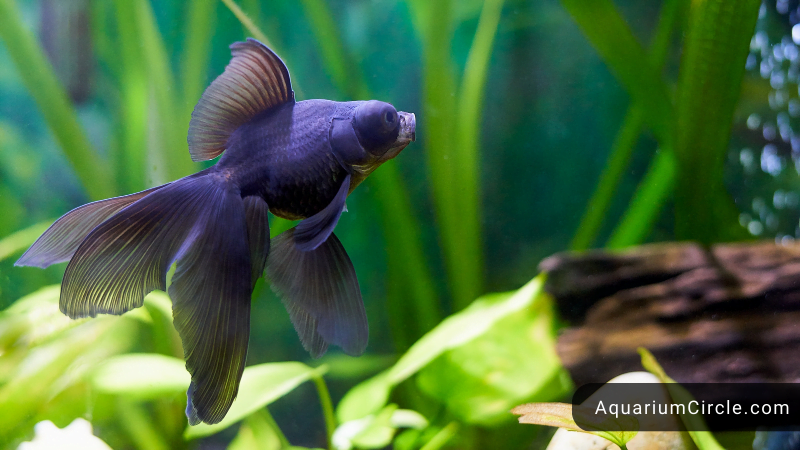The black moor goldfish is a black-colored variety of the telescope goldfish that lives in freshwater.
Most goldfish are orange, white, or red. However, the black moor goldfish is a popular goldfish among aquarists due to its magnificent black color. These fish are low-maintenance and quiet, making them perfect companions for new fishkeepers. But in some ways, although they are frequently sold to beginners as the perfect starter fish, Black Moors are not the greatest choice for a newbie to goldfish care due to their sensitive nature and vulnerability to injury.
Keep reading to figure out what you need to know so that you can decide whether you can get a black moor fish for your aquarium or not, and how to take care of these unusual but beautiful goldfish.
Related Articles:
- 5 Reasons Why Black Goldfish Turning Gold & Best Solutions
- Pink Oranda Goldfish: Top 7 Information That You Need To Know When Raising This Fish
Black Moor Goldfish: Facts & Quick Overview
| Scientific name | Carassius auratus |
| Common names | Black moor goldfish, black telescope goldfish, dragon eye goldfish, black peony goldfish, black demekin |
| Distribution | China |
| Size | 6–8 inches |
| Life expectancy | 10–15 years |
| Color | Solid black, sometimes with gold or orange patches |
| Diet | Omnivore |
| Temperament | Peaceful |
| Minimum tank size | 20 gallons |
| Temperature | 50–75°F (10–24°C) |
| pH | 6.5–7.5 |
| Hardness | 5–15 dGH |
| Care level | Easy |
| Breeding | Egg-layer |
Black Moor Goldfish Background: Origin, Distribution
Today’s goldfish are descended from the Prussian Carp, Silver Prussian Carp, or Gibel Carp Carassius gibelio (syn: Carassius auratus gibelio), which was described by Bloch in 1782. These wild carp originated in Asia, especially Central Asia (Siberia). They live by eating plants, debris, tiny crustaceans, and insects in the slow moving and stagnant waters of rivers, lakes, ponds, and ditches.
For many years, it was thought that goldfish descended from the Crucian carp, Carassius carassius, which Linnaeus described in 1758. This fish’s distribution extends from England to Russia, up north to Scandinavian nations in the Arctic Circle, and as far south as central France and the Black Sea. The recent genomic study, however, points to C. gibelio as a more likely ancestor.
Goldfish were first developed in China. Then, goldfish were exported to Japan by the 1500s, arriving in Europe in the 1600s and America in the 1800s. The majority of the fancy goldfish were created by Asian breeders. Today’s amazing colors and forms of goldfish are the consequence of this centuries-long endeavor. Domesticated goldfish are now available all over the world.
The Black Moor Goldfish is a black variation of the Telescope Goldfish, which was developed in China in the early 1700s. It was also known as the Dragon Fish or the Dragon Eyes. In Japan, it became famous as the Demekin in the late 1700s. The Dragon Eye Goldfish, Black Peony Goldfish, and Black Demekin are all names for the Black Moor. It is one of more than 125 types of captive-bred fancy goldfish.
Black Moor Goldfish Description: Appearance, Lifespan, Behaviors,…
After knowing some background information about this fish, let us continue by giving you more information about the characteristics that describe the fish to figure out what makes them so attractive and unique like that.
Appearance
To be called a Black Moor, a goldfish must have jet-black scales and telescope eyes. Other black goldfish varieties exist, but these are not real Black Moors.
They have a short, compact body with a little hump.
They, like other fancy breeds, have two caudal fins rather than one. The anal, pectoral, and pelvic fins are also paired, bringing the total number of fins to nine, including the dorsal fin.
The goldfish’s telescope eyes grow throughout 8 to 24 months of its life and appear in three various shapes: round, conical, and tubular.Circular is the most desirable shape and causes the fish the least difficulty. Tubular is an extremely rare condition that severely affects the fish’s eyesight and coordination.
Their eyes usually extend outward to the side, making it impossible for the fish to see anything head-on. In certain circumstances, their eyes will be turned forward, limiting their peripheral vision.
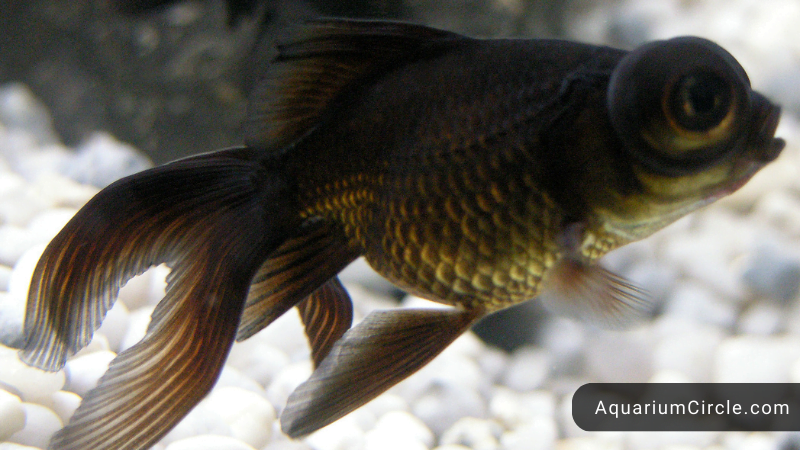
Size
In general, black moors can grow to be 6-8 inches (15-20 cm) long; but, like with any goldfish, it is always possible that your fish will rapidly beyond these estimates. They will also become quite round and egg-shaped, which will slow their progress through the water. Their huge bulging eyes also indicate poor eyesight, but black moors have less protruding eyes than usual, so eye infections are less frequent.
Colors
As we can see through the name, black moor goldfish are mostly black with golden flecks on their scales. They do, however, have a tendency to change color over their lifetimes. The color of the young tends to deepen, and as the black moors age, they might turn orange or reddish.
Furthermore, there are two types based on their tail shape: veiltail or fringetail fancy goldfish.
- Veiltail: has long, trailing fins that look like a bride’s wedding veil. To compensate for their long tails, their bodies are shorter and rounder.
- Fringetails: have thinner bodies and shorter V-shaped tails.
Sexual difference
The two genders cannot be distinguished until your fish is at least a year old.
Females, like most fish, are slightly rounder than males. They have large, swollen abdomens that are used to carry their eggs.
Mature males have little white lumps near their gill plates, which are known as breeding tubercles.
Lifespan
The lifespan of black moor goldfish might vary depending on tank size and care level.
Fish that grow in tiny containers typically have a shorter lifetime. Black moors may survive for up to 20 years if given the proper tank size and care.
However, if kept in a tiny tank or are not well cared for, they may only survive for a few years.
We will give you some different-sized containers, and let’s see how long a black moor’s lifespan can last:
- In a tank: If kept in a tiny tank with a low water level, the black moor goldfish may only live for a year or two due to a lack of oxygen. However, if it is a bigger tank with high water levels, it may survive for up to ten years.
- In an aquarium: Aquariums are preferable for black moor goldfish because they have more space and oxygen. If cared for properly, black moors may survive in an aquarium for up to 20 years.
- In a pond: Ponds are ideal habitats for black moor goldfish because they have more space and oxygen to breathe. Black moors may live in a pond for up to 20 years if the water is clean and there is sufficient food.
- In a bag: A black moor goldfish may barely survive a few hours in a bag. This is due to a lack of oxygen and an unsuitable water temperature.
- In a bowl: A black moor goldfish may only survive in a bowl for a few months. In a bowl, juvenile goldfish normally have adequate oxygen, but as they develop, their oxygen requirements rise, and they may not be able to get enough.
Typical behavior
The black moor goldfish is a calm, slow-moving fish that gets along with other fish and is not territorial. This species is energetic and has been observed chasing and nipping the fins of other black moors.
This goldfish loves to swim in the tank’s middle levels and hides when frightened by loud noises or aggressive tank mates.
Black moor goldfish are most active during the day. During the day, the fish feed and explore around the tank, and sleep in caves or under plants at night.
See also: Do Goldfish Have Personalities? – 3 Important Things For You
Black Moor Goldfish: Price And Availability
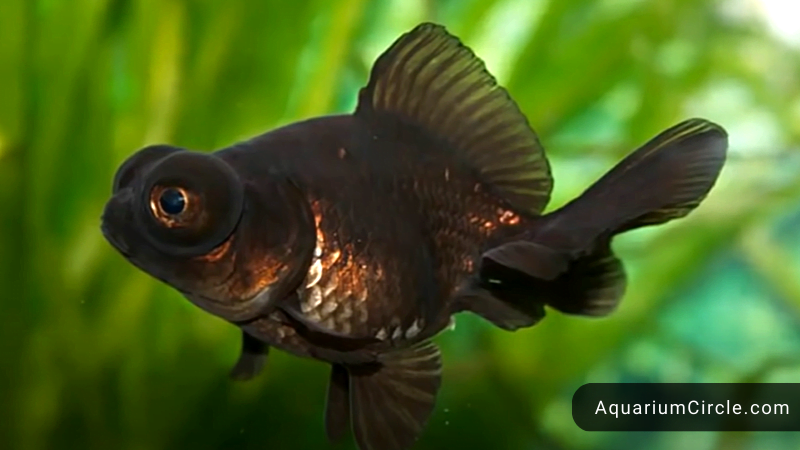
Black Moor goldfish are widely available at your local fish store. In general, these species have a wide tail form. However, you can usually find the more rare tail forms for sale online through expert breeders.
Specimens for sale in your local fish store often cost $8 or more, depending on the size, quality, and tail form of the fish.
Here are some online platforms from which you can order a goldfish:
Black Moor Goldfish Care Guide
Now, when you have owned one, or varieties of goldfish, it means that you have also taken the responsibility of taking a good care of your pets. Despite the fact that black moor goldfish are hardy enough to bear a very harsh environment, if you do not look after them properly, your black moor goldfish don’t have the ability to last for a long time. Keep reading to take note what your need for your lovely pets.
Fish keeping difficulty
The Black Moor Goldfish is one of the tougher goldfish species. They are not picky about water quality or temperature. They can survive in a goldfish aquarium or pond if the atmosphere is safe and their tankmates are not competitive.
Many people keep goldfish in aquariums without a heater or filtration, but they thrive when given the same filtration, particularly biological filtration, as other aquarium residents. Netting these fish requires extra caution since their eyes are easily injured. They should not be kept with highly competitive tankmates since they are not fast or efficient feeders.
Tank size
Black Moor goldfish can grow to be 7 inches long or even more. Juveniles develop rapidly during their first two years of life, so that lovely little black fish you got home from the fish store will quickly outgrow a small tank.
If you wish to maintain Black Moors and other types of Fancies, we recommend investing in a big tank of roughly 20 gallons. Starting with a large tank means you won’t need to upgrade later, and your fish will be more likely to flourish and develop appropriately. If you want, or your financial does not allow you, you may get started with a 10-gallon tank, it’s absolutely fine!
Because Black Moor goldfish are poor swimmers, use a rectangle tank with lots of open swimming areas. Goldfish require a lot of oxygen, and this tank form has a larger surface area for better oxygen exchange than a tall tank. Avoid deep tanks where the fish may struggle to swim to the surface to eat. If the fish cannot easily feed, they will grow anxious, which will lead to health concerns.
A tank with a lid or a cover slide is recommended. A cover will prevent evaporation, stop dust from collecting on the water, and protect the fish safely in the case of unexpected acrobatics!
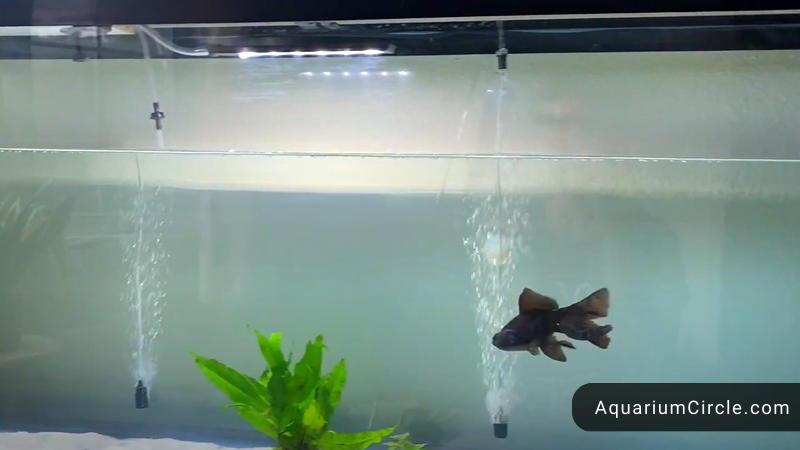
Avoid goldfish bowls!
Keep in mind: Never keep any kinds of goldfish in a bowl!
Fishbowls are too tiny for goldfish, and the surface area provided is insufficient to meet the fish’s oxygen needs. Although fish bowls were initially used to house goldfish, modern opinion holds that using a goldfish bowl for fishkeeping is cruel.
How many black moor goldfish can you keep?
Goldfish are gregarious creatures that thrive when kept in groups with other species of goldfish.
Fancy goldfish, including Black Moors, need plenty of swimming space. If the tank is overcrowded, the fish will be stressed, and health problems will most likely result, including poor growth.
As a general guideline, you should allow 1 gallon of water per 1 inch of fish in your aquarium.
Although Black Moor goldfish are tough enough to survive in an outdoor pond, their telescope eyes lead them to see poorly. As a result, the Black Moor has a hard time competing for food, and its eyes are prone to infection and damage.
Water parameters
Black Moors like lower water temperatures ranging from 65o to 72o Fahrenheit. Water hardness should be between 5 and 19 dGH, with a pH between 6.0 and 8.0.
You must test the water parameters in your aquarium once a week with a digital aquarium thermometer and an aquarium water testing kit. Nitrate levels should ideally be 20ppm or lower, and the water should have no ammonia or nitrite.
Filtration
Goldfish in general are filthy creatures that generate massive amounts of waste every day. To keep the water clean and healthy for the fish, you’ll need a high-efficiency filtration system.
The water in the aquarium must be circulated at least four times each hour by the filter to show you the water conditions. To remove solid waste and pollutants from the water, the system should have both biological and mechanical filter media. A chemical filter is not required, although it can assist remove heavy metals and pollutants. If you need to treat the water with fish medicine, you should first remove the chemical filter media.
When opting for your filter, keep in mind that Black Moors are clumsy swimmers who will struggle in a strong stream. Choose a system with an adjustable outflow valve or use plants or decorations to help buffer the flow.
Tank maintenance
If you want your fish to grow, you must keep their tank clean and well-maintained.
Every week, do a 30% water change. Remove organic debris and uneaten food from under plant bases, around decorations, and beneath internal filter output boxes with an aquarium vacuum cleaner.
Use aquascaping scissors to remove damaged or dead leaves and stems from plants that grow in aquariums. Finally, wipe away extra algae from your viewing windows with an algae scraper. You may leave some algae on the back glass for the fish to eat.
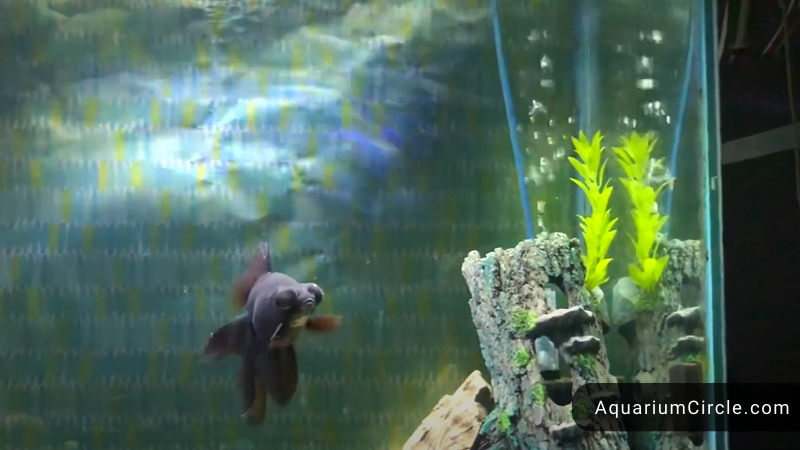
Tank setup / decoration
As previously stated, Black Moor goldfish were created by selective captive breeding and do not exist in the wild. That means you may decorate your aquarium whatever you like. However, there are a few things to consider while putting up a fish tank for Black Moors.
Safety considerations
Black Moors have large, bulging eyes and poor eyesight. If the tank is excessively crowded, the fish are prone to injury.
As a result, leave plenty of open water swimming in the middle of the water column, and place any firm decorations around the tank’s edge or on the bottom.
If you want to get a natural effect in your setup, use smooth driftwood, pebbles, or rocks. We recommend you to stay away from anything with sharp edges, such as twisted roots.
Because the fish like searching through the substrate for food leftovers, large-gauge, smooth gravel is the ideal choice for the bottom of the tank.
Planting
Living plants are a fantastic addition to any fish aquarium. The plants create oxygen and absorb CO2 and nitrates, improving the habitat for your fish.
Black Moor goldfish, on the other hand, are omnivores who like nibbling on new plant leaves. The fishes’ continual rummaging in the substrate might also uproot plants that aren’t well-anchored. Marimo Moss Balls, Java Fern, and Anubias are a few attractive plant species that may be used in a goldfish tank without causing too much damage.
Lighting
Although fish do not require light to exist, lighting can assist the poorly sighted Black Moors in finding their way around, and lighting also recreates the day/night cycle.
Knowing when it is day and when it is night is critical for the health of your fish. When the sun rises, the fish know it’s time to feed, and when the sun sets, the fish go to sleep. That obvious cycle is essential for the fish’s health and aids in stress reduction.
Of course, well-chosen aquarium lighting allows you to observe your lovely fish in all their glory. Choose a lighting unit with an auto-timer so you don’t have to bother about turning the lights on and off in your tank while you’re not around. A basic timer plug, which you can get at your local DIY shop, is a less expensive and equally efficient alternative.
Nutrition and feeding
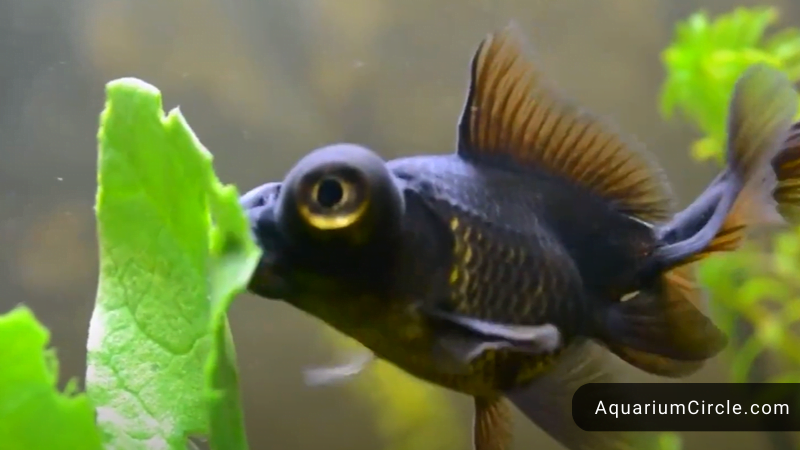
Black Moor goldfish are omnivorous creatures that consume a wide range of foods.
A well-balanced meal for your goldfish should include high-quality fish flakes, Fancy goldfish pellets, and a good quantity of meaty protein, such as frozen brine shrimp, bloodworms, and krill. Goldfish also love blanched zucchini and lettuce as treats.
Round-bodied goldfish are particularly vulnerable to illnesses like constipation and bloating, which can limit the fish’s ability to swim. These conditions usually occur when the fish is fed an excessive amount of dry food and can be quickly remedied by giving the fish a piece of meaty meal or fresh vegetables.
How much should I feed my black moor goldfish?
Every day, Black Moor goldfish require two to three small meals. To avoid overfeeding, treat the goldfish only what they will eat in two or three minutes.
Read more: How Long Can Goldfish Go Without Food
Can we feed black moor live food?
Pond carp and goldfish eat small crustaceans, insects, and insect larvae. However, we do not encourage you to put live food in your aquarium.
Live food frequently contains parasites and bacteria that may be extremely dangerous to your fish and other livestock. So, unless you can find a trusted provider or have the time to maintain a home brine shrimp hatchery, stick to frozen meaty foods.
Never, ever take live food from the wild! Your neighborhood pond may contain dangerous contaminants and parasites that you do not want in your fish tank.
What Are Suitable Tank Mates For Black Moor Goldfish?
When choosing tank mates for your Black Moor Goldfish, keep in mind that they have trouble navigating due to their low eyesight, so avoid overcrowding or overstocking your tank.
Black moor goldfish should be kept with other calm fish that will not annoy or intimidate them. Other fancy goldfish, small groups of shoaling fish, and huge, slow-swimming fish are good tank mates for black moors, such as: oranda goldfish, mollies, zebra danios, neon tetras, catfish…
The faster-swimming, slim-bodied goldfish variants will outcompete the Fancies for food, and the Black Moor’s telescope eyes are extremely prone to injury during a feeding frenzy. Fin nippers like: tiger barbs, betta fish, angelfish… and small fish and shrimp that may be eaten by larger Black Moors should also be avoided.
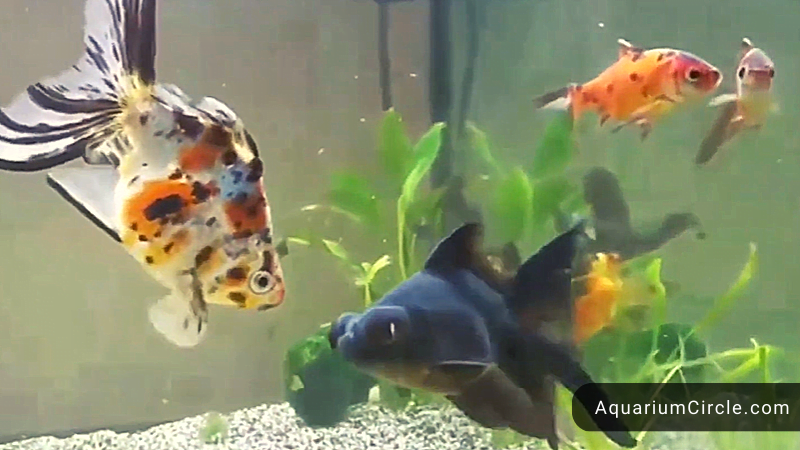
Keeping black moor goldfish together
The Black Moors should stay united. They build small shoals of 4-6 fish and participate in community eating, collective swimming, and resource sharing.
Other Telescope Goldfish, like as Red and Panda Telescopes, may coexist with Black Moors. They are frequently willing to share with one another, which eliminates the possibility of conflict inside the group.
Black Moor Goldfish: Health And Diseases
In raising and taking care of goldfish, you cannot guarantee that your pets are completely safe and free from diseases. Although Black Goldfish are very hardy, there will still be times when they will suffer from a certain disease, and if not detected early and treated properly, they may prove fatal. Continue reading to equip yourself with the knowledge of the diseases that your pets are susceptible to, thereby fully ensuring their survival in your aquarium.
Popeye disease
This is a common eye disease in goldfish, as they are less sensitive to water parameters and more prone to injury. Popeye’s disease itself is not an illness but a symptom of underlying problems that can worsen over time. If left untreated, this eye condition can lead to the goldfish losing one or both eyes.
The earliest sign of Popeye’s disease is marked swelling in one or both eyes. The fish’s eyes will bulge ferociously, letting you know that something is wrong. As the disorder progresses, other symptoms may soon appear, including:
- Distended eye socket with bloodshot eyes and inflamed eye tissue
- Cloudy or ruptured eyeball in more severe cases
- Swelling around the head and body of the fish
- Behavioral changes, including unusual hiding
- Food refusal and unexplained apathy.
If you notice these symptoms, get your goldfish treated as soon as possible.
Cloudy eye
This is not a condition but rather a symptom of some underlying conditions caused by many factors, such as injuries, improper dieting, parasitic infections or genetics.
The most relevant symptom of this disease is that the black moor’s eyes get cloudy. However, you cannot identify the illness just based on this symptom. There are more signs that show this disease, including:
- Appetite loss or refusal to eat
- White growth on the lens of the eye
- Around the eyes, or around the mouth
- Bloodshot eyeball due to color change and the appearance of red spots on the skin
- Tendency to hide or swim close the substrate, etc.
Depending on the symptoms, the goldfish may require prompt treatment in a different environment, especially if the disease is fatal.
Swim bladder disease
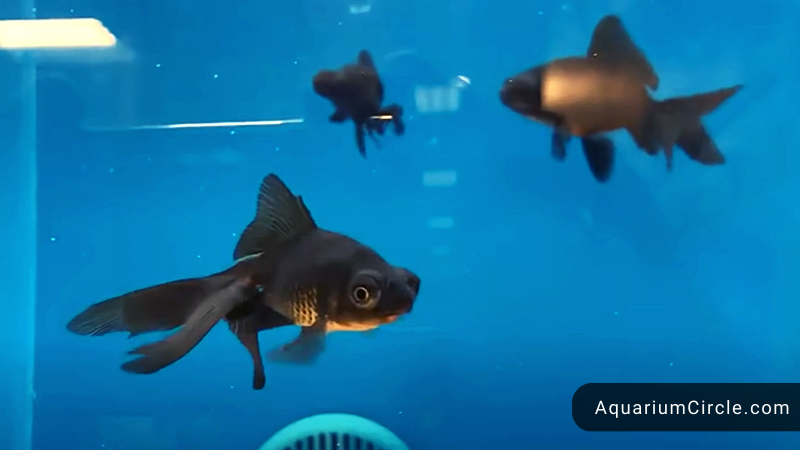
Swim Bladder Disease is a condition that mostly affects round-bodied fish, such as Black Moors, and is mainly caused by digestive problems.
The swim bladder is an organ that allows the fish to maintain an even keel when swimming. When the swim bladder is damaged, the fish finds it difficult to swim upright or maintain its position in the water, usually becoming locked at the surface or on the substrate or swimming on one side.
Constipation is a common reason of swim bladder issues, and it is generally preventable and treatable with proper nutrition.
White spot disease
White Spot Disease is also known as Ich or Ick.
This condition is caused by a parasite common in many aquariums that only attacks sick or weakened fish. In reaction to the parasites’ skin itchiness, infected fish “flash” or flick against the substrate or solid objects in the tank. The fish develops a rash of small white spots throughout the gill covers, body, and fins as the disease spreads.
White Spot is generally not fatal if treated immediately with an over-the-counter treatment available at your local fish store.
Bacterial infections
Bacterial infections show in many ways, but they all generally affect fish already sick or wounded. Symptoms vary based on the type of bacteria infecting the fish, however they can include:
- Patches of reddened skin
- Ulcers
- Lethargy
- Fins and tail that are torn or ragged
- Scales are missing.
- Appetite problems
- Breathing problems
Most minor bacterial illnesses may be treated with fish medication, which can be purchased in a local store or online.
Flukes
Fluke is a broad word that refers to external parasites that may infect freshwater fish, especially goldfish. Fluke species that are often encountered include:
- Worms that anchor themselves
- Lice on fish
- Fleas on the skin
Flukes usually arrive as hitchhikers attached to new fish, plants, or live food in your aquarium or pond.
To keep flukes out of your aquarium, we recommend keeping any new fish, invertebrates, or plants in a quarantine tank for a couple of weeks before adding them to your display tank.
Breeding Black Moor Goldfish
Black Moors are egg-layers, and if the conditions are favorable, they will readily reproduce in your aquarium.
A group of at least five fish is required to have a possibility of acquiring a mix of males and females. Outside the breeding season, it’s virtually hard to distinguish between 2 black moor sexes. When females are carrying eggs, their bodies are typically rounder than males. In ideal spawning condition, males have a sprinkling of white prickles called tubercles on their head and gill covers.
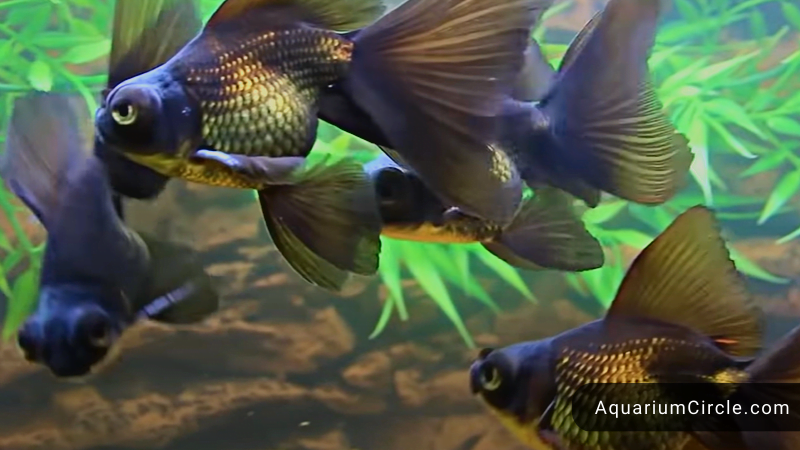
Spawning conditions
To provide an ideal environment for black moor goldfish to spawn, a spawning tank of at least 20 gallons is required. Provide big, flat rocks or spawning mops for the female fish to lay their eggs on, as well as lush planting.
Feed the fish a protein-rich diet before putting them in the spawning tank to get them into breeding conditions. Once spawning begins, you must continue to feed the fish a high-quality, high-protein diet that includes plenty of brine shrimp, bloodworms, and other similar foods.
When the water warms up in the spring, goldfish spawn, to reproduce this in your fish tank, gradually raise the temperature by a few degrees every day until it reaches a maximum temperature of 68o to 74o Fahrenheit.
You must maintain the water clean, replacing approximately 20% of the water daily until spawning begins, and remove any fish waste and uneaten food regularly.
Spawning
Black Moors may lay up to 10,000 eggs in a few hours. The male fish fertilizes the eggs after the female has laid them. At that time, you must remove both mother and father fish before they get an opportunity to eat the eggs.
After around a week, the eggs hatch and the free-swimming fry emerges. You can feed the fry fish store fry food until they can handle finely crushed flakes and baby Artemis.
Black Moor youngsters are dark bronze at first and lack the telescope eyes that distinguish them. When the young fish reach about an inch in length, they may be placed in the tank or pond with the adults.
So, Is The Black Moor Goldfish Suitable For Beginners?
Goldfish are often regarded as an appropriate pet for a beginner. However, there are few things to keep in mind before taking on a Black Moor.
Like other Fancy goldfish, the Black Moor is a nasty fish that generates a lot of waste. Goldfish are unique in that they lack a stomach. Instead, everything the fish eats is constantly passed through its digestive system, where the nutrients are removed. This basically transforms the fish into a floating waste disposal device, continually eliminating trash as it swims around your tank.
Black Moors, as previously said, are large fish that feed continuously. As a result, the amount of waste produced by the fish on a daily basis is enormous. To keep the water clean and healthy for your fish, you’ll need a powerful, effective filtration system that utilizes both mechanical and biological media. You will also need to maintain your fish tank clean by making weekly water changes to remove dangerous nitrates from the water.
Black Moors have prominent, telescopic eyes that can be injured. Because these fish have poor eyesight, they might easily miss out on feeding periods, causing stress and in severe starving circumstances,. Because of their egg-shaped bodies, all Fancy goldfish species suffer from digestive difficulties, thus they require a specialized diet.
Videos About Black Moor Goldfish
Black moor goldfish care and info
Black moor goldfish tank mates
FAQs
Should a beginner get a black moor goldfish?
No. Although they are frequently sold to beginners as the perfect starter fish, Black Moors are not the greatest choice for a newbie to goldfish care due to their sensitive nature and vulnerability to injury.
How big can a black moor goldfish get?
In general, black moors can grow to be 6-8 inches (15-20 cm) long; but, like with any goldfish, it is always possible that your fish will rapidly beyond these estimates.
What fish do black moor goldfish get along with?
Oranda goldfish, mollies, zebra danios, neon tetras, catfish… are good tank mates that black moor can get along with.

Annette M. Chaney is an experienced marine biologist with over 20 years of experience as an aquarist and fishkeeper. She started her first aquarium at a young age, filling it with frogs and goldfish obtained from the ten-cent pet store.
Annette grew up caring for and breeding African Cichlids, which led to a hobby in high school that doubled as a profitable means. Attending Reed College gave her time to solidify herself as an accomplished aquarium caretaker with an eye for sales. After that, from 2009 – 2013, she studied at Roger Williams University – one of the most prestigious universities for Aquaculture and Aquarium in USA. She is the founder of AquariumCircle since 2010.
